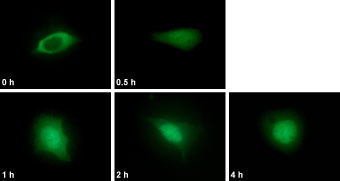Overview
- Hamamoto, T. et al. (1983) J. Antibiot. (Tokyo) 36, 639.
- Hamamoto, T. et al. (1985) J. Antibiot. (Tokyo) 38, 1573.
- Yoshida, M. et al. (1990) Exp. Cell Res. 187, 150.
- Wolff, B. et al. (1997) Chem. Biol. 4, 139.
- Kudo, N. et al. (1998) Exp. Cell Res. 242, 540.
 Alomone Labs Leptomycin B induces nuclear accumulation of NF-κB in HEK-293 cells.Cells were transiently transfected with green fluorescent protein (GFP) fused to NF-AB (NF-κB-GFP). After 3 days, the transfected cells were treated with 40 nM Leptomycin B (#L-500) and incubated for different times. The images represent the distribution of NF-κB-GFP in the cytosol which becomes nuclear upon Leptomycin B treatment.
Alomone Labs Leptomycin B induces nuclear accumulation of NF-κB in HEK-293 cells.Cells were transiently transfected with green fluorescent protein (GFP) fused to NF-AB (NF-κB-GFP). After 3 days, the transfected cells were treated with 40 nM Leptomycin B (#L-500) and incubated for different times. The images represent the distribution of NF-κB-GFP in the cytosol which becomes nuclear upon Leptomycin B treatment.
- Hamamoto, T. et al. (1983) J. Antibiot. (Tokyo) 36, 639.
- Hamamoto, T. et al. (1985) J. Antibiot. (Tokyo) 38, 1573.
- Yoshida, M. et al. (1990) Exp. Cell Res. 187, 150.
- Wolff, B. et al. (1997) Chem. Biol. 4, 139.
- Ossareh-Nazari, B. et al. (1997) Science 278, 141.
- Fornerod, M. et al. (1997) Cell 90, 1051.
- Kudo, N. et al. (1998) Exp. Cell Res. 242, 540.
Leptomycin B is an unsaturated, branched-chain fatty acid antibiotic which produced by Streptomyces sp. ATS1287.1,2 Leptomycin B was found to act as an antifungal antibiotic and reversible antiproliferative agent which arrests the cell cycle in both the G1 and G2 phases into the resting state - GO.3
In the late 90’s Leptomycin B, was found as inhibitor of the nucleo-cytoplasmic translocation process of the HIV-1 Rev protein and Rev-dependent mRNA at nanomolar concentrations and was the first low molecular weight inhibitor of nuclear export to be identified.4
The target molecule of Leptomycin B has been shown by genetic and biochemical analyses to be CRM1, a highly conserved protein in eukaryotes. CRM1 was shown to be a member of the importin beta family and a receptor for the nuclear export signal (NES) of proteins in both yeast and mammalian cells. Leptomycin B binds directly to CRM1, which results in the dissociation of the NES from the nuclear export machinery containing CRM1 and leads to the nuclear accumulation of many proteins in both yeast and mammalian cells.5-7
Thus, Leptomycin B serves as a potent tool for understanding the molecular mechanisms of nucleo-cytoplasmic transport of proteins.
Leptomycin B (#L-500) is a highly pure, natural, and biologically active compound.

